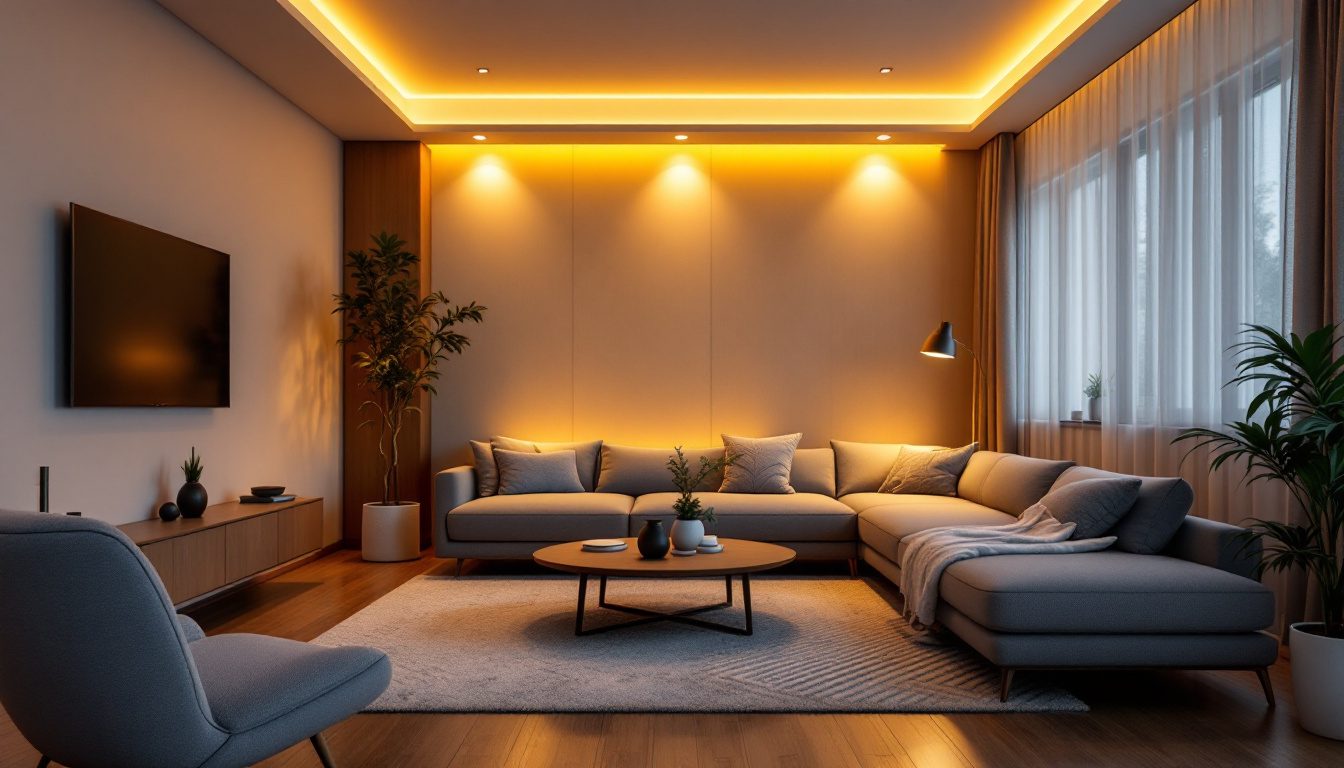

In recent years, LED technology has revolutionized the lighting industry, offering energy-efficient solutions that not only reduce electricity costs but also enhance the quality of light in various settings. For lighting contractors, understanding LED replacement can lights is essential in providing clients with the best options for their lighting needs. This article delves into the various aspects of LED replacement can lights, including their benefits, installation considerations, and the types available.
LED replacement can lights are designed to fit into existing recessed can fixtures, offering an easy upgrade from traditional incandescent or fluorescent bulbs. This transition not only improves energy efficiency but also enhances the overall aesthetic of a space. The sleek design of LED can lights allows them to blend seamlessly into ceilings, providing a modern and unobtrusive lighting solution that complements various interior styles.
These lights come in various shapes, sizes, and color temperatures, making them suitable for a wide range of applications, from residential to commercial settings. The versatility of LED can lights allows contractors to cater to diverse client preferences and requirements. For instance, in a home setting, warm white LEDs can create a cozy atmosphere in living rooms, while cooler temperatures can be ideal for task-oriented spaces like kitchens and offices, where clarity and focus are essential.
One of the most significant advantages of LED replacement can lights is their energy efficiency. LEDs consume significantly less power compared to traditional lighting options, which translates to lower energy bills for clients. Additionally, LEDs have a longer lifespan, often lasting up to 25,000 hours or more, reducing the frequency of replacements and maintenance costs. This longevity not only benefits homeowners but also commercial establishments, where minimizing downtime and maintenance disruptions is crucial for ongoing operations.
Another benefit is the quality of light produced by LEDs. They offer a range of color temperatures, from warm white to cool daylight, allowing for customization based on the desired ambiance of a space. This flexibility can enhance the overall design and functionality of any room. Moreover, many LED can lights are dimmable, providing further control over lighting levels and enabling users to adjust the mood according to different activities or times of day.
In an era where sustainability is paramount, LED replacement can lights stand out as an eco-friendly option. They contain no hazardous materials such as mercury, which is commonly found in fluorescent bulbs. Furthermore, their energy efficiency contributes to a reduction in carbon footprint, making them a responsible choice for environmentally conscious clients. The reduced energy consumption not only lowers utility costs but also decreases the demand for electricity, which can lead to less reliance on fossil fuels and a decrease in greenhouse gas emissions.
By promoting LED technology, lighting contractors can play a crucial role in fostering sustainable practices within the industry, appealing to clients who prioritize green solutions. Additionally, many manufacturers are now focusing on producing LEDs with recyclable materials, further enhancing their environmental credentials. As awareness of climate change continues to grow, the adoption of LED lighting solutions will likely become a standard practice in both new constructions and renovations, paving the way for a brighter, more sustainable future in lighting design.
Installing LED replacement can lights may seem straightforward, but there are several factors that contractors need to consider to ensure a successful installation. Understanding the existing fixtures, electrical compatibility, and local building codes is essential in delivering quality service.
Before proceeding with installation, it is vital to assess the compatibility of the LED replacement can lights with existing fixtures. Most LED can lights are designed to fit standard recessed can sizes, but it’s important to verify the dimensions and specifications to avoid any issues during installation.
Additionally, some LED models may require specific types of dimmers to function correctly. Contractors should ensure that the dimming systems in place are compatible with the chosen LED lights to prevent flickering or other performance issues.
When replacing traditional bulbs with LED options, it’s essential to evaluate the electrical system. LEDs typically operate on low voltage, which may require the installation of a compatible driver. Ensuring that the existing wiring can handle the load is crucial for safety and optimal performance.
Contractors should also be aware of the wattage ratings of the LED replacements. Using bulbs with a higher wattage than the fixture is rated for can lead to overheating and potential hazards.
Compliance with local building codes is a critical aspect of any lighting installation. Different regions may have specific regulations regarding the use of LED lighting, especially in commercial applications. Contractors should stay informed about these codes to ensure that all installations meet safety and legal standards.
Failing to adhere to local codes can result in costly fines and may jeopardize the safety of the installation, making it imperative for contractors to conduct thorough research before proceeding with any project.
LED replacement can lights come in various types, each designed to meet specific needs and preferences. Understanding these options allows contractors to provide tailored solutions for their clients.
retrofit kits are a popular choice for upgrading existing recessed can lights. These kits typically include an LED module, a trim, and all necessary hardware for installation. They are designed to fit into existing can housings, making them a convenient option for contractors looking to streamline the upgrade process.
One of the key advantages of retrofit kits is their ease of installation. Most kits come with simple instructions, allowing for quick and efficient upgrades without the need for extensive modifications to the existing fixtures.
Integrated LED can lights are a more modern solution, featuring built-in LED technology within the fixture itself. This design eliminates the need for separate bulbs, offering a sleek and contemporary look. Integrated options are often more energy-efficient and can provide better light distribution compared to traditional bulbs.
While integrated fixtures may have a higher upfront cost, they often come with longer warranties and lower maintenance requirements, making them a worthwhile investment for clients seeking longevity and performance.
For spaces where lighting flexibility is essential, adjustable and directional LED can lights offer an excellent solution. These fixtures allow users to direct light where it is needed most, making them ideal for highlighting artwork, architectural features, or specific areas within a room.
Adjustable LED can lights are particularly beneficial in commercial settings, such as retail spaces or galleries, where lighting needs may vary based on displays or events. Contractors can recommend these options to clients looking for versatility in their lighting design.
Color temperature plays a significant role in the overall ambiance of a space. LED replacement can lights are available in various color temperatures, typically measured in Kelvin (K). Understanding these options allows contractors to guide clients in selecting the ideal lighting for their needs.
Warm white LEDs emit a soft, inviting glow that is reminiscent of traditional incandescent lighting. This color temperature is often favored for residential spaces, such as living rooms and bedrooms, where a cozy atmosphere is desired. Contractors can recommend warm white options to clients looking to create a comfortable and relaxing environment.
Neutral white LEDs offer a balanced light that is neither too warm nor too cool. This color temperature is suitable for a variety of applications, including kitchens, bathrooms, and office spaces. It provides a clean and modern look while maintaining a welcoming feel. Contractors can suggest neutral white options for clients seeking versatility in their lighting choices.
Cool white LEDs produce a bright, crisp light that is ideal for task-oriented spaces such as garages, workshops, and commercial environments. This color temperature enhances visibility and focus, making it suitable for areas where precision is essential. Contractors can recommend cool white options to clients looking to improve functionality in their workspaces.
While LED replacement can lights offer numerous benefits, cost is an important factor to consider for both contractors and clients. Understanding the initial investment and long-term savings can help in making informed decisions.
The upfront cost of LED replacement can lights can be higher than traditional lighting options. However, it’s essential to consider this as a long-term investment. The energy savings and reduced maintenance costs associated with LEDs often offset the initial expenditure over time. Contractors should provide clients with a clear breakdown of potential savings to justify the investment.
LEDs are known for their energy efficiency, consuming significantly less power than incandescent or fluorescent bulbs. This translates to lower electricity bills, which can be particularly beneficial for commercial clients with extensive lighting needs. Additionally, the long lifespan of LED lights means fewer replacements, further contributing to cost savings over time.
By highlighting these long-term benefits, contractors can help clients understand the value of investing in LED technology.
LED replacement can lights represent a significant advancement in lighting technology, offering energy efficiency, versatility, and improved quality of light. For lighting contractors, understanding the various types, installation considerations, and benefits of these products is essential in providing clients with the best solutions for their lighting needs.
By staying informed about the latest trends and technologies in LED lighting, contractors can enhance their service offerings and contribute to a more sustainable future. As the demand for energy-efficient lighting continues to grow, embracing LED replacement can lights will not only benefit clients but also position contractors as leaders in the industry.
Ready to elevate your lighting installations with the most efficient, cost-effective LED replacement can lights on the market? Look no further than LumenWholesale. Our commitment to quality and affordability ensures that you have access to the best spec-grade lighting products at wholesale prices that simply can’t be beaten. Say goodbye to middleman markups and hello to a vast selection of reliable, high-performance lighting that meets the highest industry standards. Plus, with free shipping on bulk orders, you can stock up on premium lighting solutions without worrying about hidden fees. Make the smart choice for your lighting needs and experience the best value in wholesale lighting with LumenWholesale today.

Discover the essential insights lighting contractors need for commercial projects.

Discover why purchasing stairway and corridor lighting in bulk from local distributors might not be the best choice.

Discover why purchasing architectural grid mount lights in bulk from local distributors might not be the best choice.

Discover essential insights into shop lighting that every contractor should know.
Get notified when NEW deals are released.
Optimize your budget with wholesale discounts.
Only top-quality, specification-grade lighting products.
No additional costs at checkout - what you see is what you pay.
We understand the unique needs of contractors.